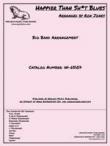WINDS OF CHANGE
Arranged by Ron Jones

Cat #: W-65109
$65.00This item usually ships within 1 business day.
Questions?
Please call +1-518-587-1102 or email us.
Edition: Jazz Big Band Arrangement
Description: Jazz Waltz - Advanced
Publisher: Walrus Music Publishing
From Composer Ron Jones:
"Level: Advanced level 6
Highest Lead Trumpet note: Written E above high C
Winds of Change is a jazz-waltz with a tempo of a dotted half=205 BPM. When I conduct the piece with my
23-piece In uence Jazz Orchestra in L.A. I feel like I’m ying or driving a powerful sports car with the top down.
This chart requires some real chops or the willingness to work on parts and it really moves along so your players
should have the ability to handle the lines and stay in the ow. This showcases every section and each player.
The solos are: Bass at the top, Vibes solo (optional piano solo) at letter C (bar 42), Tenor Sax 2 Solo at bar 106
Continuing at letter H (bar 110 ) rst time only, Trumpet 2 Solo second time only at letter H, Tenor Sax 1 Solo at
letter K (bar 154), Trombone 1 Solo at letter L (bar 170), Drum Solo at letter M (bar 184), Piano,Guitar and Vibes
Soli at bar 208, Vibes Solo at letter S (bar 274) (can also be a Piano Solo if no vibes is available).
At the top we start with a bass solo and rhythm. It is vital to establish the drive and ow of things right o the bat.
The full brass (Horns,Trumpets and Bones) play rhythmic gures in support of the basic groove and feel. The Vibes
(or piano) and rhythm section take it at letter C. Letter D has the two Alto saxes now on Flutes with three trumpets
on a owing melodic phrase as the French Horns, Bones and Bari Sax lays down the chords. Now we have some
fun asthings get contrapuntal (what a fun word, right?). Letter E features the band in counterpoint as the rhythm
section continues to drive laying down the comps, rhythm and chords.
At G things lock in with the brass and Saxes/Flutes shout section on the same rhythm together. Tenor 2 takes a
solo break at bar 106 that leads into the repeated solo section at letter H. The Tenor 2 soloist takes rst time through,
Trumpet 2 the second time. Various pads play on the second time through helping things develop and move.
Tenor 1 has the solo at letter K. The Rhythm Section has a written rhythmic gure harmonized that builds under
the solo. At letter L Trombone 1 plays with intensity against a powerful ensemble accompaniment. It is sort of a
battle section really. To relieve the pressure I give the Drums a big open solo at letter M. The band gets a break l
etting the blood come back into the chops and getting ready to hit it with energy after the drum solo. Letter N
starts with a recap of things stated at the beginning. Bar 208 gives the Rhythm section a written soli as Sax and
Bone pads decend. The trumpets answer those lines with their own leading to letter O where the Saxes take o
with an extention of what was started in 208. Now the full brass hits with heavy punches behind the saxes.
We are in overdrive at this point. Bar 220 starts a sort of dog ght between the Saxes and Brasses. It is tense with
two-bar trade-o statements back and forth. At last we reach the pay o at letter P. The Saxes and French Horns
take the melodic lead as it all comes together. Joining in the counterpoint the trumpets enter with their cool lines
that weave in and around the main melody. The Bones and Rhythm Section keep on cooking along underneath
sustaining the strong sense of drive and forward motion.
Everything progresses along until bar 268 where the full ensemble has four dotted quarters in Tutti. The Saxes
escape the tutti with a melodic escape pod (I guess the Saxes won the battle?).
Letter S is where things start to settle down with Saxes playing decending lines in dotted half-notes. The
Trumpets grab Harmons and enter with melodic fragments on top. The trumpets pass on the melodic devices
to the trombones that bring us to the nal resting clustered chord. A solo trumpet in Harmon plays the last lick.
Hey gang this chart is wild and takes the listeners and the band through an amusement park of ups and downs,
tension and release. It challenges the skills and talent of any band yet is fun and powerful.
Enjoy!"
2 Alto Saxophones
2 Tenor Saxophones
Baritone Saxophone
4 Trumpets
2 Horns in F
3 Trombones
Bass Trombone
Guitar
Piano
Bass
Vibraphone
Drums
Congas






![POCKETS OF TIME [DOWNLOAD] View: POCKETS OF TIME [DOWNLOAD]](https://www.ejazzlines.com/wp-images/product/thumbnail/w65108.jpg)

